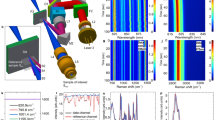Abstract
I HAVE previously described a new approach to direct radioassay of aqueous solutions of weak betaray emitting isotopes in the liquid scintillation spectrometer1. The aqueous solution was intimately mixed with a mass of finely divided beads of clear plastic into which a fluor (diphenylstilbene) has been incorporated (Pilot B-Beads, Pilot Chemicals, Inc., Watertown, Mass.). We wish to report that a number of crystalline fluors, more efficient, less expensive and more generally available, can be substituted for the plastic and used in an analogous fashion despite their poorer light-transmitting qualities2. For example, in a slurry made up of 0.7 ml. Na2 14CO3 and 0.5 gm. diphenyloxazole the carbon-14 was counted with 27 per cent efficiency. Instead of trying to hold the solid fluor in stable suspension, which can be done with the help of thickeners such as glycerol, it has proved more satisfactory to let the fluor settle to the bottom of the vial. Addition of a detergent is essential to ensure prompt and uniform wetting of the crystals. The performance of a fluor depends not only on its inherent fluorescence efficiency but also on the size and shape of the crystals, since the closeness of packing determines the mean free path of beta-particles through the solution before they encounter a fluor crystal. Best results thus far have been obtained using blue-violet fluorescence-grade anthracene crystals (Distillation Products Industries. Rochester, N.Y.). This highly purified material was three times as efficient as ordinary ‘chemically pure’ anthracene. The difference may in part reflect the presence of trace impurities in the latter, known to shift the fluorescence to higher wave-lengths. Even different lots of fluorescence-grade anthracene may differ by 20–30 per cent in efficiency, but the material in any given lot gave excellent reproducibility without further treatment. A routine technique currently used in our laboratories for carbon-14 and tritium is described.
This is a preview of subscription content, access via your institution
Access options
Subscribe to this journal
Receive 51 print issues and online access
$199.00 per year
only $3.90 per issue
Buy this article
- Purchase on Springer Link
- Instant access to full article PDF
Prices may be subject to local taxes which are calculated during checkout
Similar content being viewed by others
References
Steinberg, D., Nature, 182, 740 (1958).
Presented in part at Symposium on Advances in Tracer Applications of Tritium, October 31, 1958, New York City.
Author information
Authors and Affiliations
Rights and permissions
About this article
Cite this article
STEINBERG, D. Radioassay of Aqueous Solutions mixed with Solid Crystalline Fluors. Nature 183, 1253–1254 (1959). https://doi.org/10.1038/1831253b0
Issue Date:
DOI: https://doi.org/10.1038/1831253b0
This article is cited by
-
Measurement of carbon‐14 and tritium in the effluent of a gas chromatography column
Journal of the American Oil Chemists' Society (1967)
-
A Simple Device for the Scintillation Counting of Aqueous Solutions of Calcium-45 and other β-Emitting Isotopes
Nature (1966)
-
Radioassay by Gas Chromatography of Compounds labelled with Carbon-14
Nature (1960)
Comments
By submitting a comment you agree to abide by our Terms and Community Guidelines. If you find something abusive or that does not comply with our terms or guidelines please flag it as inappropriate.



